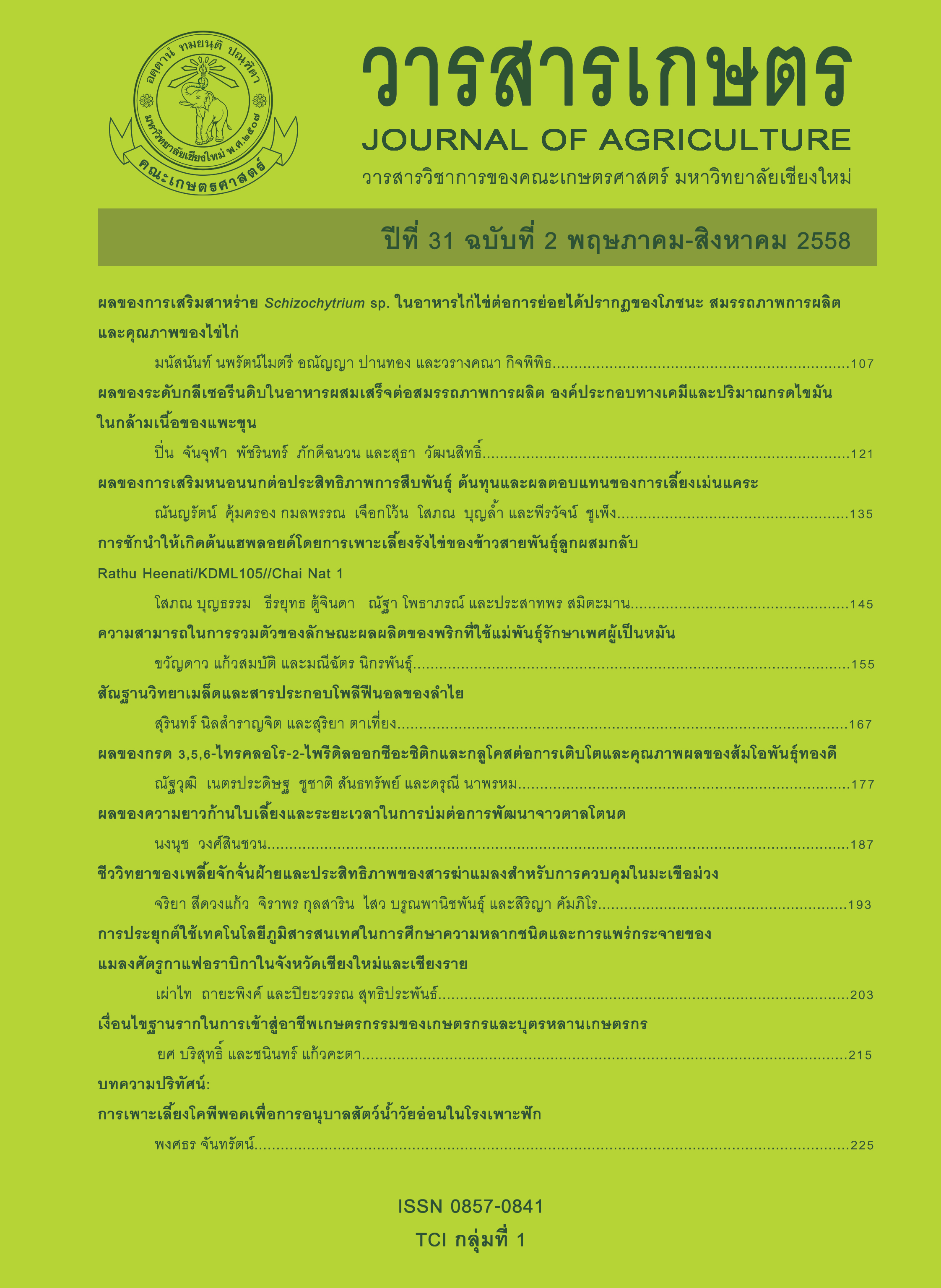สัณฐานวิทยาเมล็ดและสารประกอบโพลีฟีนอลของลำไย
Main Article Content
บทคัดย่อ
ลักษณะทางสัณฐานวิทยาเมล็ดและสารประกอบโพลีฟีนอลของลำไยพันธุ์ต่าง ๆ ที่ปลูกในแปลงรวบรวมเชื้อพันธุ์ของสถานีวิจัยและพัฒนาลำไยหริภุญไชยได้ศึกษาระยะผลแก่ในเดือนกรกฎาคม พ.ศ. 2556 โดยแยกการศึกษาพันธุ์ลำไยเป็นกลุ่มที่ 1 พันธุ์ที่ปลูกในภาคเหนือของประเทศไทยและภูมิภาคอื่น ๆ จำนวน 8 พันธุ์ กลุ่มที่ 2 เป็นกลุ่มพันธุ์ดอ จำนวน 17 พันธุ์ โดยศึกษาจากลักษณะกายภาพของเมล็ดและการหาปริมาณสารประกอบโพลีฟีนอลด้วยวิธีโครมาโทกราฟีของเหลวสมรรถนะสูง ผลการศึกษาพบว่า ลักษณะเมล็ดของพันธุ์เพชรยะลา เถา และเวียดนาม มีขนาดใหญ่กว่าพันธุ์ที่มีการปลูกทางภาคเหนือ ขณะที่พันธุ์พวงทองมีขนาดเมล็ดเล็กที่สุดในทุกลักษณะที่ศึกษา รูปร่างของเมล็ดในบางพันธุ์สามารถใช้จำแนกเป็นลักษณะเฉพาะพันธุ์ได้ ส่วนปริมาณสารประกอบโพลีฟีนอลในเมล็ด พบว่าปริมาณกรดแกลลิกน้อยกว่ากรดเอลลาจิก ในพันธุ์เถามีปริมาณกรดทั้งสองชนิดน้อยกว่าทุกพันธุ์ที่ศึกษา การเปรียบเทียบเฉพาะในกลุ่มพันธุ์ดอแสดงให้เห็นว่าพันธุ์ดออัณฑะสุนัขเป็นพันธุ์ที่มีขนาดเมล็ดใหญ่ แต่มีปริมาณสารประกอบโพลีฟีนอลน้อย โดยพันธุ์ดอก้านแข็งมีปริมาณกรดแกลลิกและกรดเอลลาจิกสูง มีค่าเท่ากับ 1.21 ±0.14 และ 2.22 ±0.14 มิลลิกรัมต่อกรัม ตามลำดับ
Article Details
เอกสารอ้างอิง
มนตรี แสนสุข. 2551. เทคโนโลยีการเกษตร. (ระบบออนไลน์). แหล่งข้อมูล: http://info.matichon.co.th/techno/techno. php (7 กรกฏาคม 2557).
วิชา ธิติประเสริฐ. 2546. ฐานข้อมูลเชื้อพันธุ์พืช: ลำไย. ชุมนุมสหกรณ์การเกษตรแห่งประเทศไทย, กรุงเทพฯ. 100 หน้า.
วีณา จิรัจฉริยากูล. 2534. ยาและผลิตภัณฑ์จากธรรมชาติ. ภาควิชาเภสัชวินิจฉัย คณะเภสัชศาสตร์ มหาวิทยาลัยมหิดล, กรุงเทพฯ. 499 หน้า.
สลิลรัตน์ วิชัยพานิช. 2547. การจำแนกลำไยพันธุ์ดอโดยวิธีสัณฐานวิทยา เซลล์พันธุศาสตร์ และอิเล็กโทรโฟรีซิส. วิทยานิพนธ์วิทยาศาสตรมหาบัณฑิต มหาวิทยาลัยเชียงใหม่, เชียงใหม่. 146 หน้า.
He, N., Z. Wang, C. Yang, Y. Lu, D. Sun, Y. Wang, W. Shao and Q. Li. 2009. Isolation and identification of polyphenolic compounds in longan pericarp. Separation and Purification Technology 70: 219-224.
Maisuthisakul, P. 2008. Antiradical scavenging activity and polyphenolic compounds extracted from Thai mango seed kernels. Asian Journal of Food and Agro-Industry 1(2): 87-96.
Rangkadilok, N., S. Tongchusak, R. Boonhok, S. C. Chaiyaroj, V. B. Junyaprasert, W. Buajeeb, J. Akanimanee, T. Raksasuk, T. Suddhasthira and J. Satayavivad. 2012. In vitro antifungal activities of longan (Dimocarpus longan Lour.) seed extract. Fitoterapia. 83(3): 545-553.
Soong, Y. Y. and P. J. Barlow. 2005. Isolation and structure elucidation of phenolic compounds from longan (Dimocarpus longan Lour.) seed by high-performance liquid chromatography-electrospray ionization mass spectrometry. Journal of Chromatography A 1085: 270-277.
Soong, Y. Y. and P. J. Barlow. 2006. Quantification of gallic acid and ellagic acid from longan (Dimocarpus longan Lour.) seed and mango (Mangifera indica L.) kernel and their effects on antioxidant activity. Food Chemistry 97: 524-530.
Sudjaroen, Y., W. E. Hull, G. Erben, G. Wurtele, S. Changbumrung, C. M. Ulrich and R. W. Owen. 2012. Isolation and characterization of ellagitannins as the major polyphenolic components of longan (Dimocarpus longan Lour.) seeds. Phytochemistry 77: 226-237.
Sundaresan, V. 2005. Control of seed size in plants. Proceedings of the National Academy of Sciences 102(50): 17887-17888.
Yang, B., Y. Jiang, J. Shi, F. Chen and M. Ashraf. 2011. Extraction and pharmacological properties of bioactive compounds from longan (Dimocarpus longan Lour.) fruit. Food Research International 44: 1837-1842.


